Carbon Capture and Storage in Canada: Technology, Impacts, and Future
VerifiedAdded on 2022/11/23
|17
|4246
|410
Report
AI Summary
This report provides a comprehensive analysis of Carbon Capture and Storage (CCS) in Canada. It begins with an introduction to CCS, defining its role in capturing waste CO2 from sources like power plants and factories and storing it to mitigate global warming and ocean acidification. The report t...
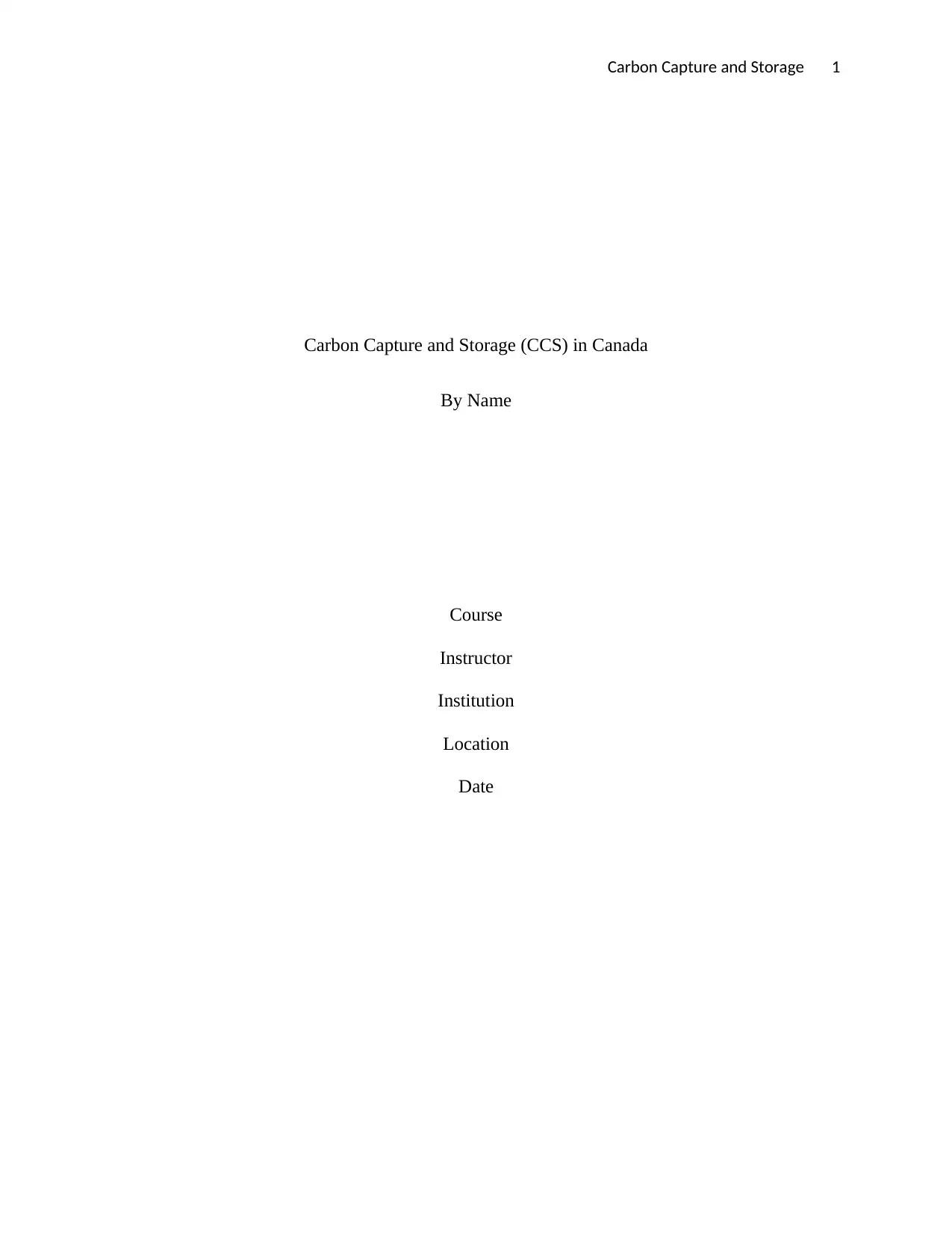
Carbon Capture and Storage 1
Carbon Capture and Storage (CCS) in Canada
By Name
Course
Instructor
Institution
Location
Date
Carbon Capture and Storage (CCS) in Canada
By Name
Course
Instructor
Institution
Location
Date
Paraphrase This Document
Need a fresh take? Get an instant paraphrase of this document with our AI Paraphraser
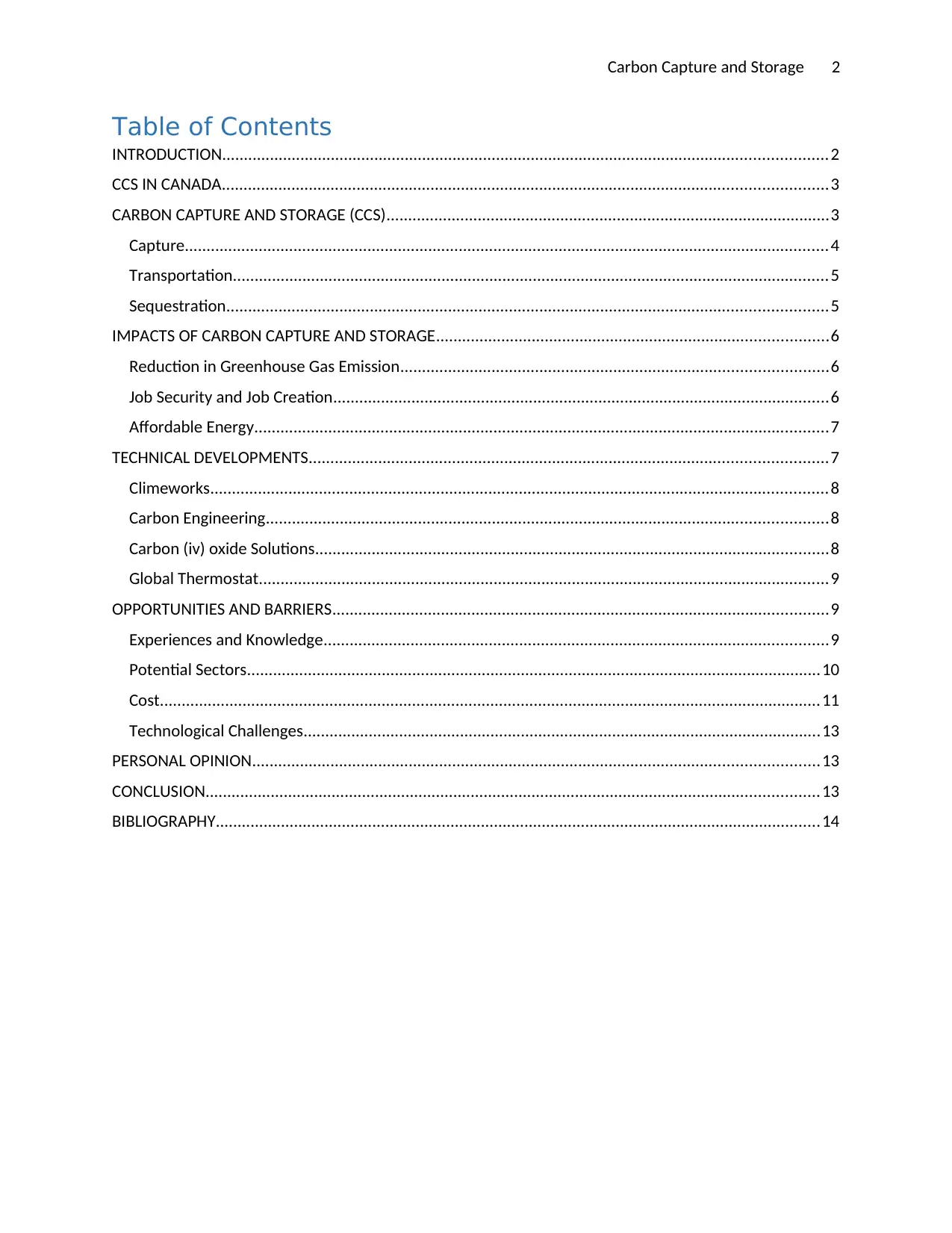
Carbon Capture and Storage 2
Table of Contents
INTRODUCTION...........................................................................................................................................2
CCS IN CANADA...........................................................................................................................................3
CARBON CAPTURE AND STORAGE (CCS)......................................................................................................3
Capture....................................................................................................................................................4
Transportation.........................................................................................................................................5
Sequestration..........................................................................................................................................5
IMPACTS OF CARBON CAPTURE AND STORAGE..........................................................................................6
Reduction in Greenhouse Gas Emission..................................................................................................6
Job Security and Job Creation..................................................................................................................6
Affordable Energy....................................................................................................................................7
TECHNICAL DEVELOPMENTS.......................................................................................................................7
Climeworks..............................................................................................................................................8
Carbon Engineering.................................................................................................................................8
Carbon (iv) oxide Solutions......................................................................................................................8
Global Thermostat...................................................................................................................................9
OPPORTUNITIES AND BARRIERS..................................................................................................................9
Experiences and Knowledge....................................................................................................................9
Potential Sectors....................................................................................................................................10
Cost........................................................................................................................................................11
Technological Challenges.......................................................................................................................13
PERSONAL OPINION..................................................................................................................................13
CONCLUSION.............................................................................................................................................13
BIBLIOGRAPHY...........................................................................................................................................14
Table of Contents
INTRODUCTION...........................................................................................................................................2
CCS IN CANADA...........................................................................................................................................3
CARBON CAPTURE AND STORAGE (CCS)......................................................................................................3
Capture....................................................................................................................................................4
Transportation.........................................................................................................................................5
Sequestration..........................................................................................................................................5
IMPACTS OF CARBON CAPTURE AND STORAGE..........................................................................................6
Reduction in Greenhouse Gas Emission..................................................................................................6
Job Security and Job Creation..................................................................................................................6
Affordable Energy....................................................................................................................................7
TECHNICAL DEVELOPMENTS.......................................................................................................................7
Climeworks..............................................................................................................................................8
Carbon Engineering.................................................................................................................................8
Carbon (iv) oxide Solutions......................................................................................................................8
Global Thermostat...................................................................................................................................9
OPPORTUNITIES AND BARRIERS..................................................................................................................9
Experiences and Knowledge....................................................................................................................9
Potential Sectors....................................................................................................................................10
Cost........................................................................................................................................................11
Technological Challenges.......................................................................................................................13
PERSONAL OPINION..................................................................................................................................13
CONCLUSION.............................................................................................................................................13
BIBLIOGRAPHY...........................................................................................................................................14
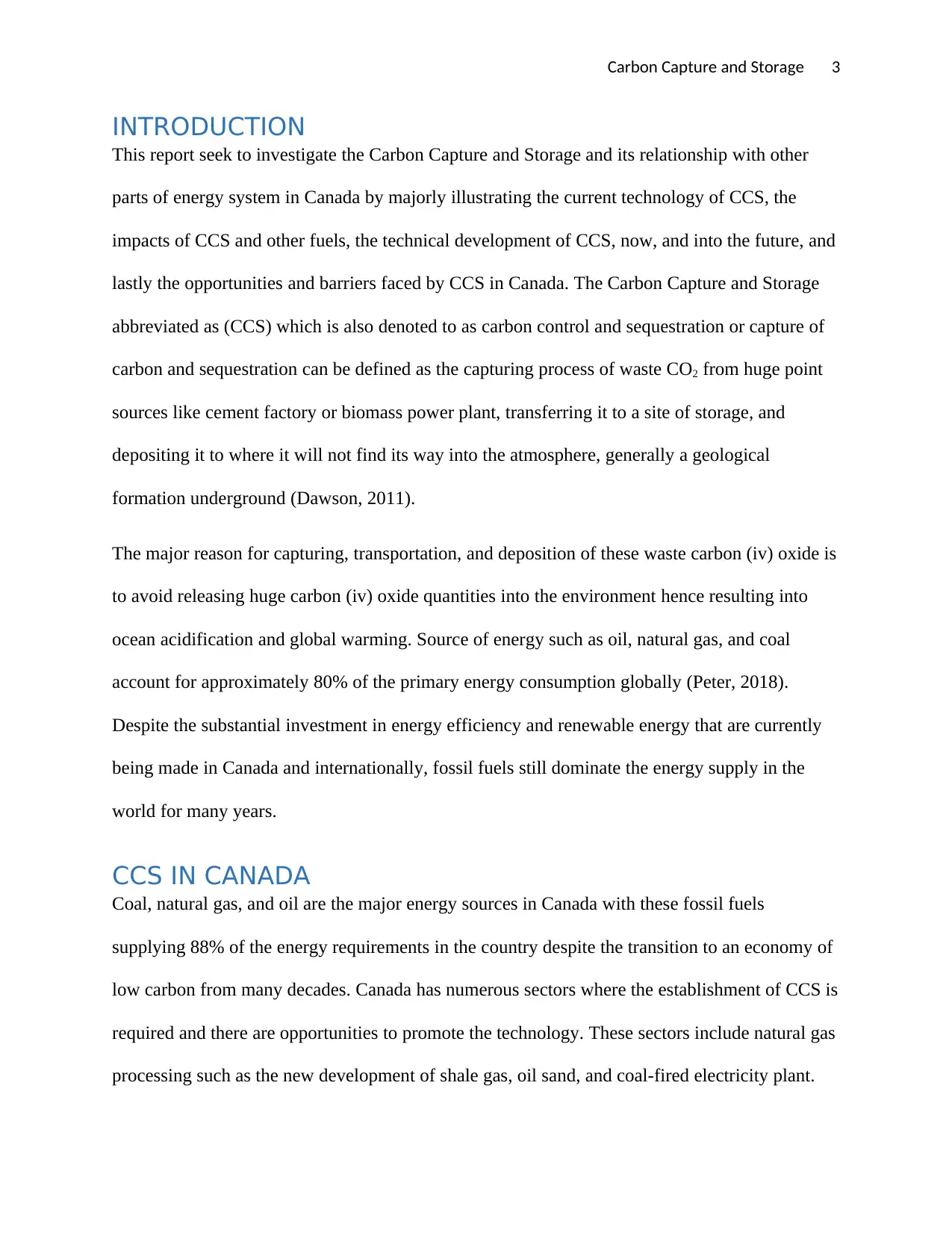
Carbon Capture and Storage 3
INTRODUCTION
This report seek to investigate the Carbon Capture and Storage and its relationship with other
parts of energy system in Canada by majorly illustrating the current technology of CCS, the
impacts of CCS and other fuels, the technical development of CCS, now, and into the future, and
lastly the opportunities and barriers faced by CCS in Canada. The Carbon Capture and Storage
abbreviated as (CCS) which is also denoted to as carbon control and sequestration or capture of
carbon and sequestration can be defined as the capturing process of waste CO2 from huge point
sources like cement factory or biomass power plant, transferring it to a site of storage, and
depositing it to where it will not find its way into the atmosphere, generally a geological
formation underground (Dawson, 2011).
The major reason for capturing, transportation, and deposition of these waste carbon (iv) oxide is
to avoid releasing huge carbon (iv) oxide quantities into the environment hence resulting into
ocean acidification and global warming. Source of energy such as oil, natural gas, and coal
account for approximately 80% of the primary energy consumption globally (Peter, 2018).
Despite the substantial investment in energy efficiency and renewable energy that are currently
being made in Canada and internationally, fossil fuels still dominate the energy supply in the
world for many years.
CCS IN CANADA
Coal, natural gas, and oil are the major energy sources in Canada with these fossil fuels
supplying 88% of the energy requirements in the country despite the transition to an economy of
low carbon from many decades. Canada has numerous sectors where the establishment of CCS is
required and there are opportunities to promote the technology. These sectors include natural gas
processing such as the new development of shale gas, oil sand, and coal-fired electricity plant.
INTRODUCTION
This report seek to investigate the Carbon Capture and Storage and its relationship with other
parts of energy system in Canada by majorly illustrating the current technology of CCS, the
impacts of CCS and other fuels, the technical development of CCS, now, and into the future, and
lastly the opportunities and barriers faced by CCS in Canada. The Carbon Capture and Storage
abbreviated as (CCS) which is also denoted to as carbon control and sequestration or capture of
carbon and sequestration can be defined as the capturing process of waste CO2 from huge point
sources like cement factory or biomass power plant, transferring it to a site of storage, and
depositing it to where it will not find its way into the atmosphere, generally a geological
formation underground (Dawson, 2011).
The major reason for capturing, transportation, and deposition of these waste carbon (iv) oxide is
to avoid releasing huge carbon (iv) oxide quantities into the environment hence resulting into
ocean acidification and global warming. Source of energy such as oil, natural gas, and coal
account for approximately 80% of the primary energy consumption globally (Peter, 2018).
Despite the substantial investment in energy efficiency and renewable energy that are currently
being made in Canada and internationally, fossil fuels still dominate the energy supply in the
world for many years.
CCS IN CANADA
Coal, natural gas, and oil are the major energy sources in Canada with these fossil fuels
supplying 88% of the energy requirements in the country despite the transition to an economy of
low carbon from many decades. Canada has numerous sectors where the establishment of CCS is
required and there are opportunities to promote the technology. These sectors include natural gas
processing such as the new development of shale gas, oil sand, and coal-fired electricity plant.
⊘ This is a preview!⊘
Do you want full access?
Subscribe today to unlock all pages.

Trusted by 1+ million students worldwide
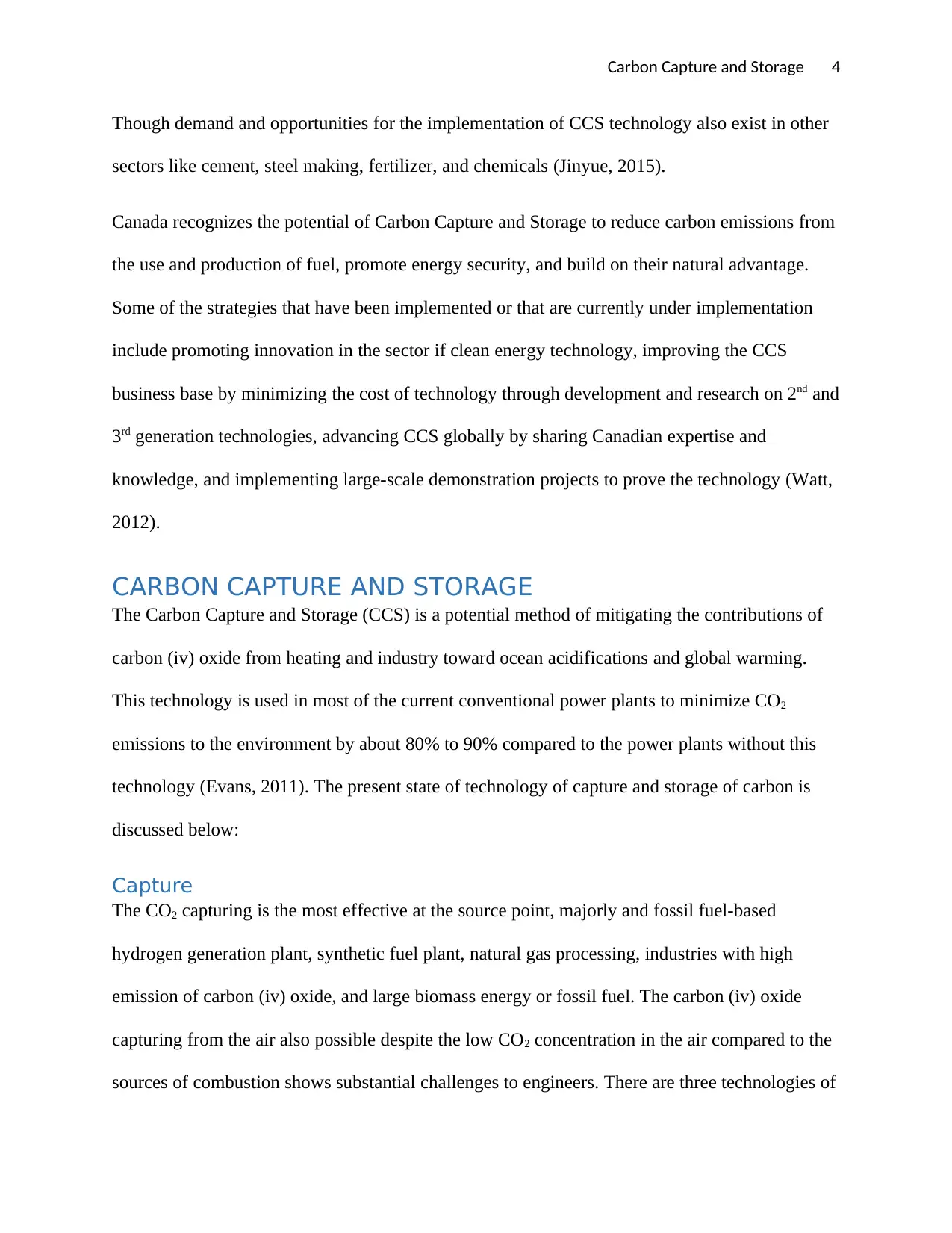
Carbon Capture and Storage 4
Though demand and opportunities for the implementation of CCS technology also exist in other
sectors like cement, steel making, fertilizer, and chemicals (Jinyue, 2015).
Canada recognizes the potential of Carbon Capture and Storage to reduce carbon emissions from
the use and production of fuel, promote energy security, and build on their natural advantage.
Some of the strategies that have been implemented or that are currently under implementation
include promoting innovation in the sector if clean energy technology, improving the CCS
business base by minimizing the cost of technology through development and research on 2nd and
3rd generation technologies, advancing CCS globally by sharing Canadian expertise and
knowledge, and implementing large-scale demonstration projects to prove the technology (Watt,
2012).
CARBON CAPTURE AND STORAGE
The Carbon Capture and Storage (CCS) is a potential method of mitigating the contributions of
carbon (iv) oxide from heating and industry toward ocean acidifications and global warming.
This technology is used in most of the current conventional power plants to minimize CO2
emissions to the environment by about 80% to 90% compared to the power plants without this
technology (Evans, 2011). The present state of technology of capture and storage of carbon is
discussed below:
Capture
The CO2 capturing is the most effective at the source point, majorly and fossil fuel-based
hydrogen generation plant, synthetic fuel plant, natural gas processing, industries with high
emission of carbon (iv) oxide, and large biomass energy or fossil fuel. The carbon (iv) oxide
capturing from the air also possible despite the low CO2 concentration in the air compared to the
sources of combustion shows substantial challenges to engineers. There are three technologies of
Though demand and opportunities for the implementation of CCS technology also exist in other
sectors like cement, steel making, fertilizer, and chemicals (Jinyue, 2015).
Canada recognizes the potential of Carbon Capture and Storage to reduce carbon emissions from
the use and production of fuel, promote energy security, and build on their natural advantage.
Some of the strategies that have been implemented or that are currently under implementation
include promoting innovation in the sector if clean energy technology, improving the CCS
business base by minimizing the cost of technology through development and research on 2nd and
3rd generation technologies, advancing CCS globally by sharing Canadian expertise and
knowledge, and implementing large-scale demonstration projects to prove the technology (Watt,
2012).
CARBON CAPTURE AND STORAGE
The Carbon Capture and Storage (CCS) is a potential method of mitigating the contributions of
carbon (iv) oxide from heating and industry toward ocean acidifications and global warming.
This technology is used in most of the current conventional power plants to minimize CO2
emissions to the environment by about 80% to 90% compared to the power plants without this
technology (Evans, 2011). The present state of technology of capture and storage of carbon is
discussed below:
Capture
The CO2 capturing is the most effective at the source point, majorly and fossil fuel-based
hydrogen generation plant, synthetic fuel plant, natural gas processing, industries with high
emission of carbon (iv) oxide, and large biomass energy or fossil fuel. The carbon (iv) oxide
capturing from the air also possible despite the low CO2 concentration in the air compared to the
sources of combustion shows substantial challenges to engineers. There are three technologies of
Paraphrase This Document
Need a fresh take? Get an instant paraphrase of this document with our AI Paraphraser

Carbon Capture and Storage 5
CO2 that are currently under application, namely oxyfuel combustion, pre-combusting, and post-
combustion. In the oxy-fuel combustion, instead of air, the fuels are burned in oxygen. The flue
gas cooled is injected and recirculated into the combustion chamber to regulate the temperature
of resulting flame to common levels during the conventional combustion (Forbes, 2010). The
composition of flue gas is majorly water vapours and carbon dioxide and the outcome is purely
CO2, and water vapour can be condensed by cooling. The outcome is nearly pure CO2 stream
which can be conveyed to the site of sequestration and stored.
Figure 1: Carbon Capture and Storage value chain (Jones & Edward Maginn, 2010)
Pre-Combustion technology is applied widely in power production, gaseous fuel, chemical, and
fertilizer. In these cases, fossil fuel undergo oxidation partially, for example, is a gasifier. The
carbon monoxide from the resultant syngas reacts with steam added and is shifted into H2 and
CO2 and H2. The resulting CO2 can be collected from a moderately pure exhaust stream. In the
capture of post-combustion, the CO2 is eliminated after the fossil fuel combustion. In this case,
carbon (iv) oxide is collecte from flue gases at large point sources or power stations. CO2 can be
separated out of flue gas or air with membrane gas separation, adsorption, and absorption.
CO2 that are currently under application, namely oxyfuel combustion, pre-combusting, and post-
combustion. In the oxy-fuel combustion, instead of air, the fuels are burned in oxygen. The flue
gas cooled is injected and recirculated into the combustion chamber to regulate the temperature
of resulting flame to common levels during the conventional combustion (Forbes, 2010). The
composition of flue gas is majorly water vapours and carbon dioxide and the outcome is purely
CO2, and water vapour can be condensed by cooling. The outcome is nearly pure CO2 stream
which can be conveyed to the site of sequestration and stored.
Figure 1: Carbon Capture and Storage value chain (Jones & Edward Maginn, 2010)
Pre-Combustion technology is applied widely in power production, gaseous fuel, chemical, and
fertilizer. In these cases, fossil fuel undergo oxidation partially, for example, is a gasifier. The
carbon monoxide from the resultant syngas reacts with steam added and is shifted into H2 and
CO2 and H2. The resulting CO2 can be collected from a moderately pure exhaust stream. In the
capture of post-combustion, the CO2 is eliminated after the fossil fuel combustion. In this case,
carbon (iv) oxide is collecte from flue gases at large point sources or power stations. CO2 can be
separated out of flue gas or air with membrane gas separation, adsorption, and absorption.

Carbon Capture and Storage 6
Transportation
The CO2 is then transported to appropriate sites for storage after capturing. This is majorly done
by pipeline since it is normally the inexpensive transportation means for huge CO2 volumes.
However, there are significant questions unanswered about pipeline safety, regulatory
classification of carbon (iv) oxide, utility cost recovery, economic regulations, and pipeline
network requirements. (Xie, 2014)
Sequestration
There have been numerous ways in which CO2 can be permanently stored. These storage forms
of CO2 include soli storage through the reaction of carbon (iv) oxide with metal oxides to
generate carbonates that are stable and gaseous storage in numerous deep geological
developments like exhaust gas fields and saline for formations. Geological storage is a technique
that entails injection of CO2, normally in supercritical form, into the underground geological
formations directly (Harrison & Falcone, 2013). An unmineable coal seams, saline formations,
saline-filled formations, gas fields, and oil fields have been recommended as the sites for storage.
Another sequestration method is enhanced oil recovery which involves increasing the quantity of
crude oil which may be extracted from oil fields. In sequestration and carbon capture-enhanced
oil recovery, there is CO2 injection into an oil field to recover oil that is normally never
recovered by the use of more conventional approaches.
IMPACTS OF CARBON CAPTURE AND STORAGE
Reduction in Greenhouse Gas Emission
The sources of energy like oil, natural gas, and coal currently for approximately 80% of the
primary energy consumption globally. The International Energy Agency has predicted that as the
world economy continues to grow, fossil fuels will continue dominating the supply of energy in
the world for decades despite the significant investments in the energy efficiency and renewable
Transportation
The CO2 is then transported to appropriate sites for storage after capturing. This is majorly done
by pipeline since it is normally the inexpensive transportation means for huge CO2 volumes.
However, there are significant questions unanswered about pipeline safety, regulatory
classification of carbon (iv) oxide, utility cost recovery, economic regulations, and pipeline
network requirements. (Xie, 2014)
Sequestration
There have been numerous ways in which CO2 can be permanently stored. These storage forms
of CO2 include soli storage through the reaction of carbon (iv) oxide with metal oxides to
generate carbonates that are stable and gaseous storage in numerous deep geological
developments like exhaust gas fields and saline for formations. Geological storage is a technique
that entails injection of CO2, normally in supercritical form, into the underground geological
formations directly (Harrison & Falcone, 2013). An unmineable coal seams, saline formations,
saline-filled formations, gas fields, and oil fields have been recommended as the sites for storage.
Another sequestration method is enhanced oil recovery which involves increasing the quantity of
crude oil which may be extracted from oil fields. In sequestration and carbon capture-enhanced
oil recovery, there is CO2 injection into an oil field to recover oil that is normally never
recovered by the use of more conventional approaches.
IMPACTS OF CARBON CAPTURE AND STORAGE
Reduction in Greenhouse Gas Emission
The sources of energy like oil, natural gas, and coal currently for approximately 80% of the
primary energy consumption globally. The International Energy Agency has predicted that as the
world economy continues to grow, fossil fuels will continue dominating the supply of energy in
the world for decades despite the significant investments in the energy efficiency and renewable
⊘ This is a preview!⊘
Do you want full access?
Subscribe today to unlock all pages.

Trusted by 1+ million students worldwide
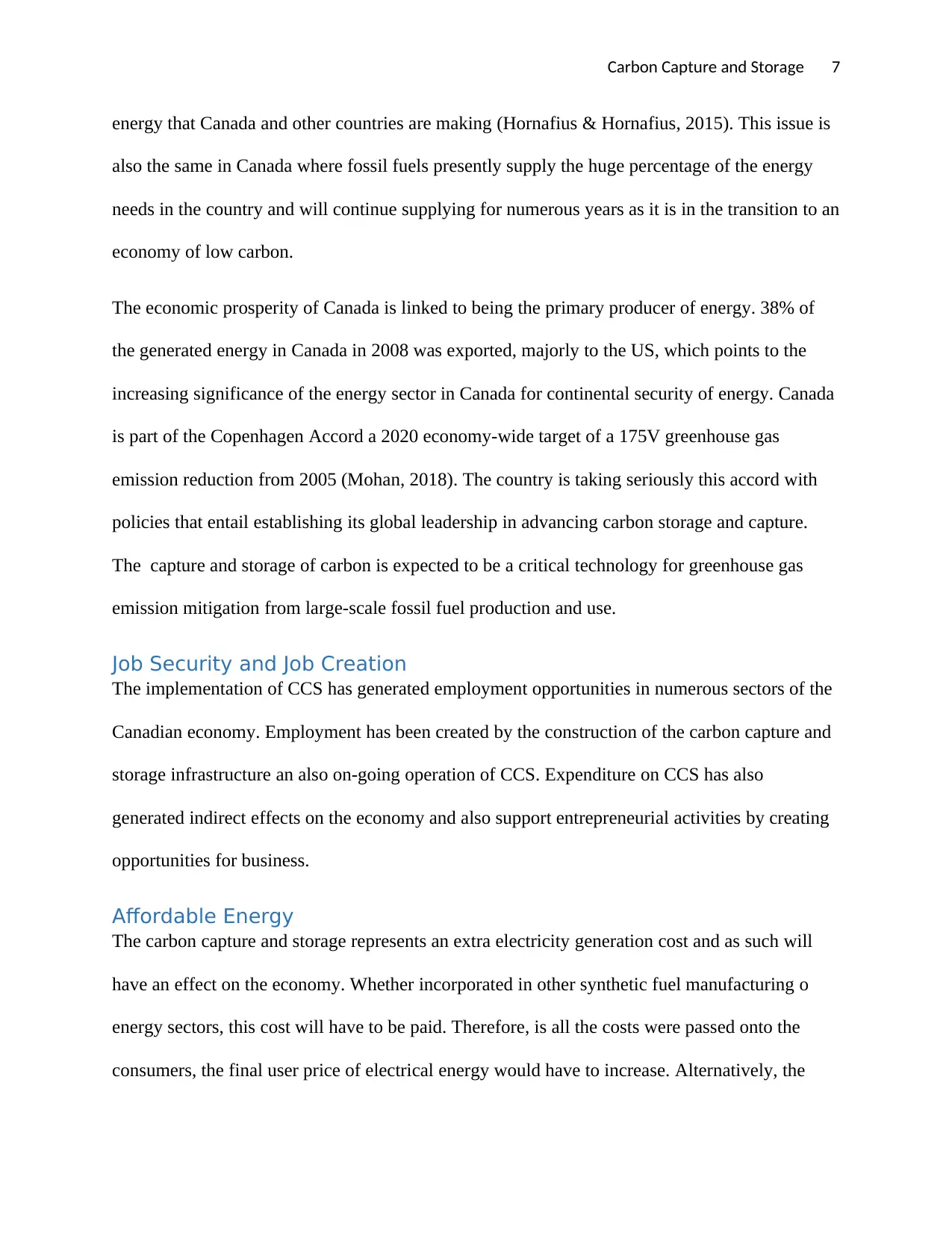
Carbon Capture and Storage 7
energy that Canada and other countries are making (Hornafius & Hornafius, 2015). This issue is
also the same in Canada where fossil fuels presently supply the huge percentage of the energy
needs in the country and will continue supplying for numerous years as it is in the transition to an
economy of low carbon.
The economic prosperity of Canada is linked to being the primary producer of energy. 38% of
the generated energy in Canada in 2008 was exported, majorly to the US, which points to the
increasing significance of the energy sector in Canada for continental security of energy. Canada
is part of the Copenhagen Accord a 2020 economy-wide target of a 175V greenhouse gas
emission reduction from 2005 (Mohan, 2018). The country is taking seriously this accord with
policies that entail establishing its global leadership in advancing carbon storage and capture.
The capture and storage of carbon is expected to be a critical technology for greenhouse gas
emission mitigation from large-scale fossil fuel production and use.
Job Security and Job Creation
The implementation of CCS has generated employment opportunities in numerous sectors of the
Canadian economy. Employment has been created by the construction of the carbon capture and
storage infrastructure an also on-going operation of CCS. Expenditure on CCS has also
generated indirect effects on the economy and also support entrepreneurial activities by creating
opportunities for business.
Affordable Energy
The carbon capture and storage represents an extra electricity generation cost and as such will
have an effect on the economy. Whether incorporated in other synthetic fuel manufacturing o
energy sectors, this cost will have to be paid. Therefore, is all the costs were passed onto the
consumers, the final user price of electrical energy would have to increase. Alternatively, the
energy that Canada and other countries are making (Hornafius & Hornafius, 2015). This issue is
also the same in Canada where fossil fuels presently supply the huge percentage of the energy
needs in the country and will continue supplying for numerous years as it is in the transition to an
economy of low carbon.
The economic prosperity of Canada is linked to being the primary producer of energy. 38% of
the generated energy in Canada in 2008 was exported, majorly to the US, which points to the
increasing significance of the energy sector in Canada for continental security of energy. Canada
is part of the Copenhagen Accord a 2020 economy-wide target of a 175V greenhouse gas
emission reduction from 2005 (Mohan, 2018). The country is taking seriously this accord with
policies that entail establishing its global leadership in advancing carbon storage and capture.
The capture and storage of carbon is expected to be a critical technology for greenhouse gas
emission mitigation from large-scale fossil fuel production and use.
Job Security and Job Creation
The implementation of CCS has generated employment opportunities in numerous sectors of the
Canadian economy. Employment has been created by the construction of the carbon capture and
storage infrastructure an also on-going operation of CCS. Expenditure on CCS has also
generated indirect effects on the economy and also support entrepreneurial activities by creating
opportunities for business.
Affordable Energy
The carbon capture and storage represents an extra electricity generation cost and as such will
have an effect on the economy. Whether incorporated in other synthetic fuel manufacturing o
energy sectors, this cost will have to be paid. Therefore, is all the costs were passed onto the
consumers, the final user price of electrical energy would have to increase. Alternatively, the
Paraphrase This Document
Need a fresh take? Get an instant paraphrase of this document with our AI Paraphraser
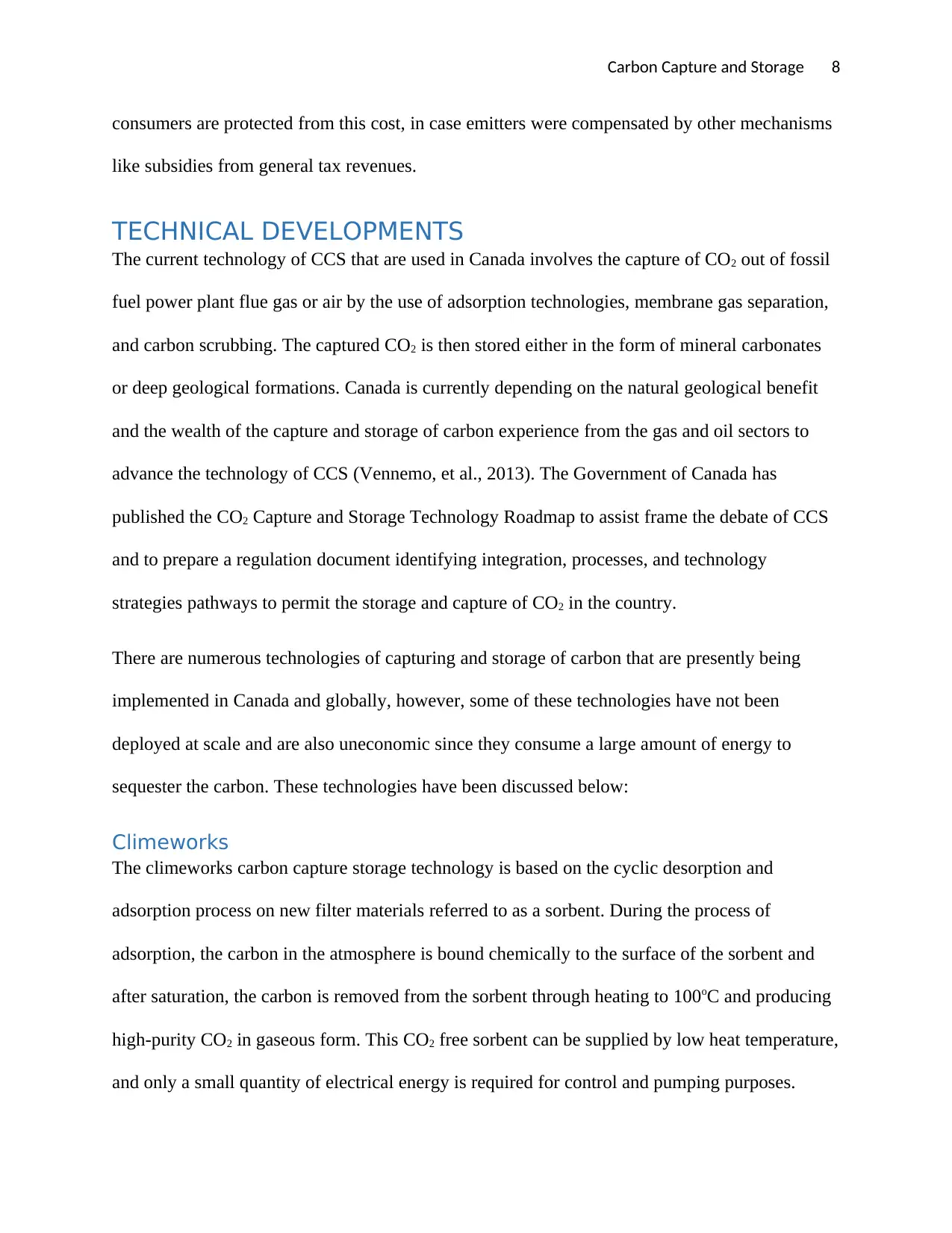
Carbon Capture and Storage 8
consumers are protected from this cost, in case emitters were compensated by other mechanisms
like subsidies from general tax revenues.
TECHNICAL DEVELOPMENTS
The current technology of CCS that are used in Canada involves the capture of CO2 out of fossil
fuel power plant flue gas or air by the use of adsorption technologies, membrane gas separation,
and carbon scrubbing. The captured CO2 is then stored either in the form of mineral carbonates
or deep geological formations. Canada is currently depending on the natural geological benefit
and the wealth of the capture and storage of carbon experience from the gas and oil sectors to
advance the technology of CCS (Vennemo, et al., 2013). The Government of Canada has
published the CO2 Capture and Storage Technology Roadmap to assist frame the debate of CCS
and to prepare a regulation document identifying integration, processes, and technology
strategies pathways to permit the storage and capture of CO2 in the country.
There are numerous technologies of capturing and storage of carbon that are presently being
implemented in Canada and globally, however, some of these technologies have not been
deployed at scale and are also uneconomic since they consume a large amount of energy to
sequester the carbon. These technologies have been discussed below:
Climeworks
The climeworks carbon capture storage technology is based on the cyclic desorption and
adsorption process on new filter materials referred to as a sorbent. During the process of
adsorption, the carbon in the atmosphere is bound chemically to the surface of the sorbent and
after saturation, the carbon is removed from the sorbent through heating to 100oC and producing
high-purity CO2 in gaseous form. This CO2 free sorbent can be supplied by low heat temperature,
and only a small quantity of electrical energy is required for control and pumping purposes.
consumers are protected from this cost, in case emitters were compensated by other mechanisms
like subsidies from general tax revenues.
TECHNICAL DEVELOPMENTS
The current technology of CCS that are used in Canada involves the capture of CO2 out of fossil
fuel power plant flue gas or air by the use of adsorption technologies, membrane gas separation,
and carbon scrubbing. The captured CO2 is then stored either in the form of mineral carbonates
or deep geological formations. Canada is currently depending on the natural geological benefit
and the wealth of the capture and storage of carbon experience from the gas and oil sectors to
advance the technology of CCS (Vennemo, et al., 2013). The Government of Canada has
published the CO2 Capture and Storage Technology Roadmap to assist frame the debate of CCS
and to prepare a regulation document identifying integration, processes, and technology
strategies pathways to permit the storage and capture of CO2 in the country.
There are numerous technologies of capturing and storage of carbon that are presently being
implemented in Canada and globally, however, some of these technologies have not been
deployed at scale and are also uneconomic since they consume a large amount of energy to
sequester the carbon. These technologies have been discussed below:
Climeworks
The climeworks carbon capture storage technology is based on the cyclic desorption and
adsorption process on new filter materials referred to as a sorbent. During the process of
adsorption, the carbon in the atmosphere is bound chemically to the surface of the sorbent and
after saturation, the carbon is removed from the sorbent through heating to 100oC and producing
high-purity CO2 in gaseous form. This CO2 free sorbent can be supplied by low heat temperature,
and only a small quantity of electrical energy is required for control and pumping purposes.
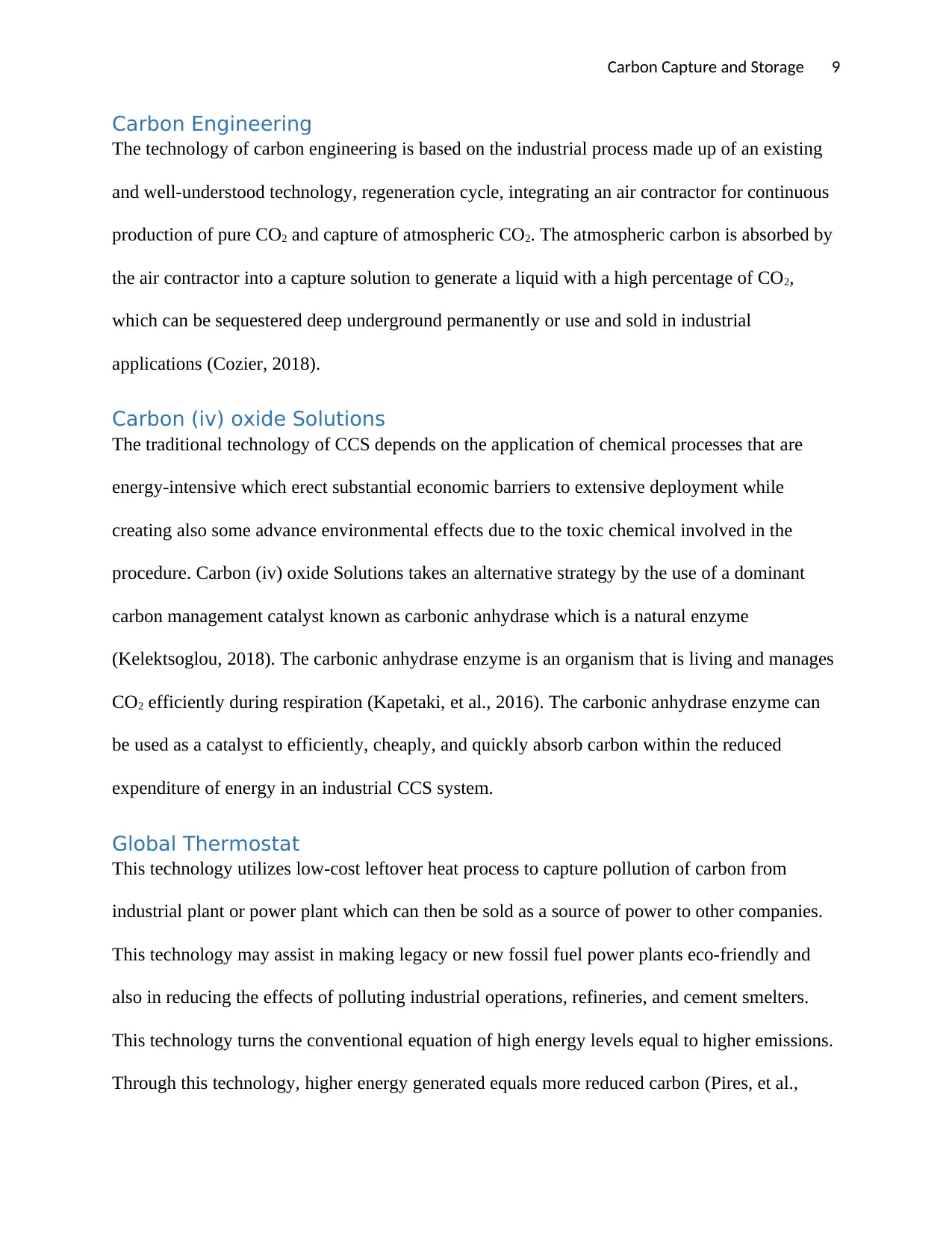
Carbon Capture and Storage 9
Carbon Engineering
The technology of carbon engineering is based on the industrial process made up of an existing
and well-understood technology, regeneration cycle, integrating an air contractor for continuous
production of pure CO2 and capture of atmospheric CO2. The atmospheric carbon is absorbed by
the air contractor into a capture solution to generate a liquid with a high percentage of CO2,
which can be sequestered deep underground permanently or use and sold in industrial
applications (Cozier, 2018).
Carbon (iv) oxide Solutions
The traditional technology of CCS depends on the application of chemical processes that are
energy-intensive which erect substantial economic barriers to extensive deployment while
creating also some advance environmental effects due to the toxic chemical involved in the
procedure. Carbon (iv) oxide Solutions takes an alternative strategy by the use of a dominant
carbon management catalyst known as carbonic anhydrase which is a natural enzyme
(Kelektsoglou, 2018). The carbonic anhydrase enzyme is an organism that is living and manages
CO2 efficiently during respiration (Kapetaki, et al., 2016). The carbonic anhydrase enzyme can
be used as a catalyst to efficiently, cheaply, and quickly absorb carbon within the reduced
expenditure of energy in an industrial CCS system.
Global Thermostat
This technology utilizes low-cost leftover heat process to capture pollution of carbon from
industrial plant or power plant which can then be sold as a source of power to other companies.
This technology may assist in making legacy or new fossil fuel power plants eco-friendly and
also in reducing the effects of polluting industrial operations, refineries, and cement smelters.
This technology turns the conventional equation of high energy levels equal to higher emissions.
Through this technology, higher energy generated equals more reduced carbon (Pires, et al.,
Carbon Engineering
The technology of carbon engineering is based on the industrial process made up of an existing
and well-understood technology, regeneration cycle, integrating an air contractor for continuous
production of pure CO2 and capture of atmospheric CO2. The atmospheric carbon is absorbed by
the air contractor into a capture solution to generate a liquid with a high percentage of CO2,
which can be sequestered deep underground permanently or use and sold in industrial
applications (Cozier, 2018).
Carbon (iv) oxide Solutions
The traditional technology of CCS depends on the application of chemical processes that are
energy-intensive which erect substantial economic barriers to extensive deployment while
creating also some advance environmental effects due to the toxic chemical involved in the
procedure. Carbon (iv) oxide Solutions takes an alternative strategy by the use of a dominant
carbon management catalyst known as carbonic anhydrase which is a natural enzyme
(Kelektsoglou, 2018). The carbonic anhydrase enzyme is an organism that is living and manages
CO2 efficiently during respiration (Kapetaki, et al., 2016). The carbonic anhydrase enzyme can
be used as a catalyst to efficiently, cheaply, and quickly absorb carbon within the reduced
expenditure of energy in an industrial CCS system.
Global Thermostat
This technology utilizes low-cost leftover heat process to capture pollution of carbon from
industrial plant or power plant which can then be sold as a source of power to other companies.
This technology may assist in making legacy or new fossil fuel power plants eco-friendly and
also in reducing the effects of polluting industrial operations, refineries, and cement smelters.
This technology turns the conventional equation of high energy levels equal to higher emissions.
Through this technology, higher energy generated equals more reduced carbon (Pires, et al.,
⊘ This is a preview!⊘
Do you want full access?
Subscribe today to unlock all pages.

Trusted by 1+ million students worldwide
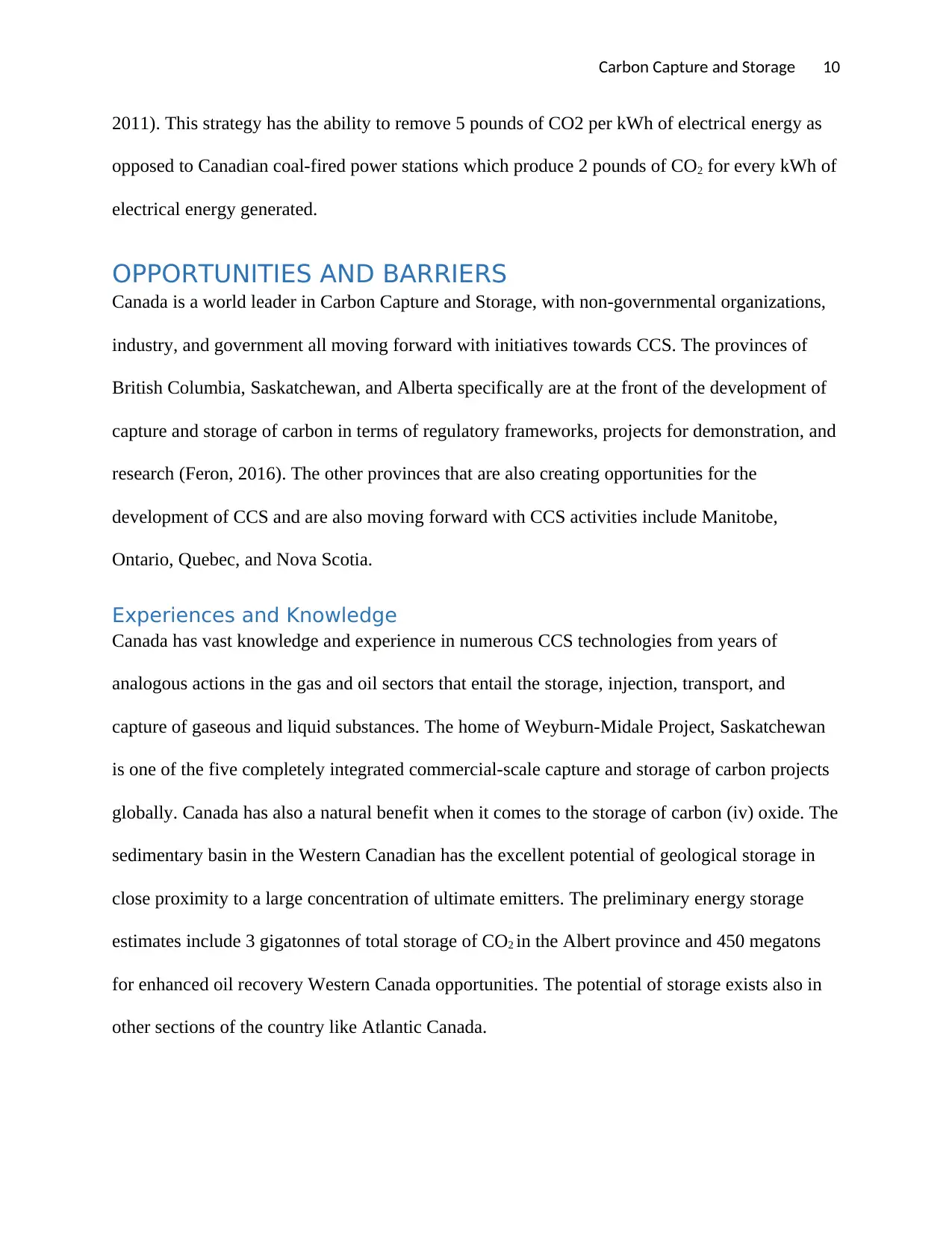
Carbon Capture and Storage 10
2011). This strategy has the ability to remove 5 pounds of CO2 per kWh of electrical energy as
opposed to Canadian coal-fired power stations which produce 2 pounds of CO2 for every kWh of
electrical energy generated.
OPPORTUNITIES AND BARRIERS
Canada is a world leader in Carbon Capture and Storage, with non-governmental organizations,
industry, and government all moving forward with initiatives towards CCS. The provinces of
British Columbia, Saskatchewan, and Alberta specifically are at the front of the development of
capture and storage of carbon in terms of regulatory frameworks, projects for demonstration, and
research (Feron, 2016). The other provinces that are also creating opportunities for the
development of CCS and are also moving forward with CCS activities include Manitobe,
Ontario, Quebec, and Nova Scotia.
Experiences and Knowledge
Canada has vast knowledge and experience in numerous CCS technologies from years of
analogous actions in the gas and oil sectors that entail the storage, injection, transport, and
capture of gaseous and liquid substances. The home of Weyburn-Midale Project, Saskatchewan
is one of the five completely integrated commercial-scale capture and storage of carbon projects
globally. Canada has also a natural benefit when it comes to the storage of carbon (iv) oxide. The
sedimentary basin in the Western Canadian has the excellent potential of geological storage in
close proximity to a large concentration of ultimate emitters. The preliminary energy storage
estimates include 3 gigatonnes of total storage of CO2 in the Albert province and 450 megatons
for enhanced oil recovery Western Canada opportunities. The potential of storage exists also in
other sections of the country like Atlantic Canada.
2011). This strategy has the ability to remove 5 pounds of CO2 per kWh of electrical energy as
opposed to Canadian coal-fired power stations which produce 2 pounds of CO2 for every kWh of
electrical energy generated.
OPPORTUNITIES AND BARRIERS
Canada is a world leader in Carbon Capture and Storage, with non-governmental organizations,
industry, and government all moving forward with initiatives towards CCS. The provinces of
British Columbia, Saskatchewan, and Alberta specifically are at the front of the development of
capture and storage of carbon in terms of regulatory frameworks, projects for demonstration, and
research (Feron, 2016). The other provinces that are also creating opportunities for the
development of CCS and are also moving forward with CCS activities include Manitobe,
Ontario, Quebec, and Nova Scotia.
Experiences and Knowledge
Canada has vast knowledge and experience in numerous CCS technologies from years of
analogous actions in the gas and oil sectors that entail the storage, injection, transport, and
capture of gaseous and liquid substances. The home of Weyburn-Midale Project, Saskatchewan
is one of the five completely integrated commercial-scale capture and storage of carbon projects
globally. Canada has also a natural benefit when it comes to the storage of carbon (iv) oxide. The
sedimentary basin in the Western Canadian has the excellent potential of geological storage in
close proximity to a large concentration of ultimate emitters. The preliminary energy storage
estimates include 3 gigatonnes of total storage of CO2 in the Albert province and 450 megatons
for enhanced oil recovery Western Canada opportunities. The potential of storage exists also in
other sections of the country like Atlantic Canada.
Paraphrase This Document
Need a fresh take? Get an instant paraphrase of this document with our AI Paraphraser
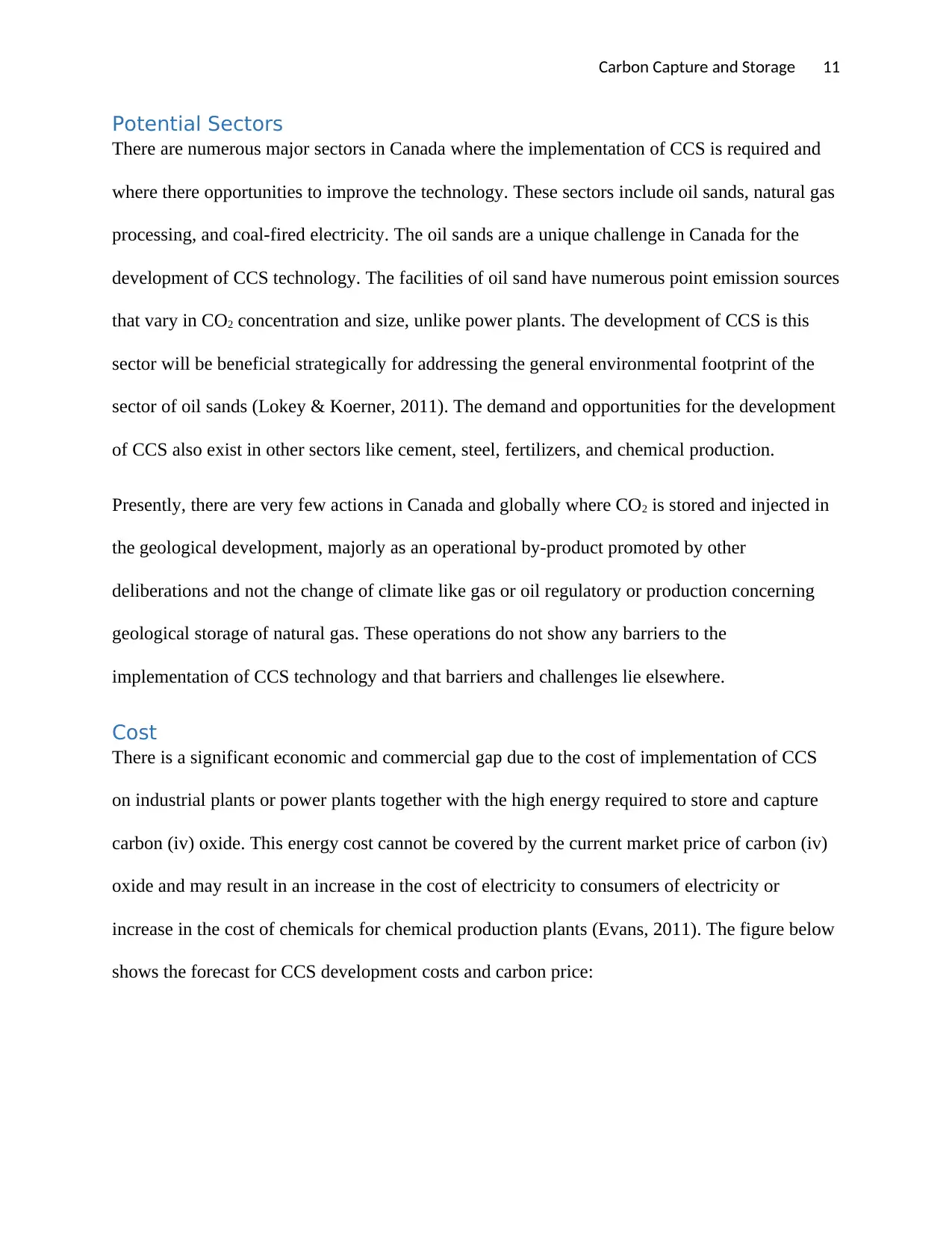
Carbon Capture and Storage 11
Potential Sectors
There are numerous major sectors in Canada where the implementation of CCS is required and
where there opportunities to improve the technology. These sectors include oil sands, natural gas
processing, and coal-fired electricity. The oil sands are a unique challenge in Canada for the
development of CCS technology. The facilities of oil sand have numerous point emission sources
that vary in CO2 concentration and size, unlike power plants. The development of CCS is this
sector will be beneficial strategically for addressing the general environmental footprint of the
sector of oil sands (Lokey & Koerner, 2011). The demand and opportunities for the development
of CCS also exist in other sectors like cement, steel, fertilizers, and chemical production.
Presently, there are very few actions in Canada and globally where CO2 is stored and injected in
the geological development, majorly as an operational by-product promoted by other
deliberations and not the change of climate like gas or oil regulatory or production concerning
geological storage of natural gas. These operations do not show any barriers to the
implementation of CCS technology and that barriers and challenges lie elsewhere.
Cost
There is a significant economic and commercial gap due to the cost of implementation of CCS
on industrial plants or power plants together with the high energy required to store and capture
carbon (iv) oxide. This energy cost cannot be covered by the current market price of carbon (iv)
oxide and may result in an increase in the cost of electricity to consumers of electricity or
increase in the cost of chemicals for chemical production plants (Evans, 2011). The figure below
shows the forecast for CCS development costs and carbon price:
Potential Sectors
There are numerous major sectors in Canada where the implementation of CCS is required and
where there opportunities to improve the technology. These sectors include oil sands, natural gas
processing, and coal-fired electricity. The oil sands are a unique challenge in Canada for the
development of CCS technology. The facilities of oil sand have numerous point emission sources
that vary in CO2 concentration and size, unlike power plants. The development of CCS is this
sector will be beneficial strategically for addressing the general environmental footprint of the
sector of oil sands (Lokey & Koerner, 2011). The demand and opportunities for the development
of CCS also exist in other sectors like cement, steel, fertilizers, and chemical production.
Presently, there are very few actions in Canada and globally where CO2 is stored and injected in
the geological development, majorly as an operational by-product promoted by other
deliberations and not the change of climate like gas or oil regulatory or production concerning
geological storage of natural gas. These operations do not show any barriers to the
implementation of CCS technology and that barriers and challenges lie elsewhere.
Cost
There is a significant economic and commercial gap due to the cost of implementation of CCS
on industrial plants or power plants together with the high energy required to store and capture
carbon (iv) oxide. This energy cost cannot be covered by the current market price of carbon (iv)
oxide and may result in an increase in the cost of electricity to consumers of electricity or
increase in the cost of chemicals for chemical production plants (Evans, 2011). The figure below
shows the forecast for CCS development costs and carbon price:
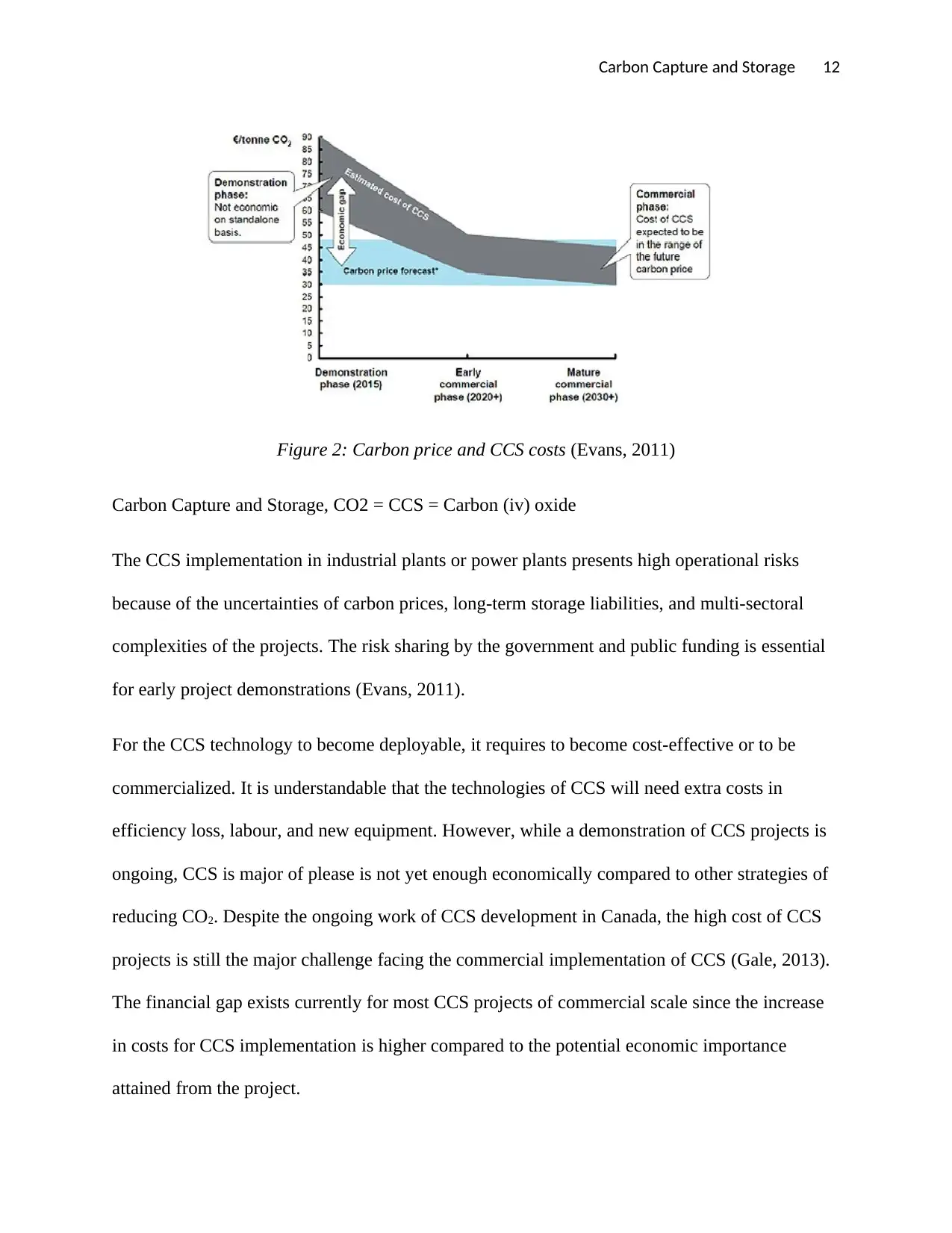
Carbon Capture and Storage 12
Figure 2: Carbon price and CCS costs (Evans, 2011)
Carbon Capture and Storage, CO2 = CCS = Carbon (iv) oxide
The CCS implementation in industrial plants or power plants presents high operational risks
because of the uncertainties of carbon prices, long-term storage liabilities, and multi-sectoral
complexities of the projects. The risk sharing by the government and public funding is essential
for early project demonstrations (Evans, 2011).
For the CCS technology to become deployable, it requires to become cost-effective or to be
commercialized. It is understandable that the technologies of CCS will need extra costs in
efficiency loss, labour, and new equipment. However, while a demonstration of CCS projects is
ongoing, CCS is major of please is not yet enough economically compared to other strategies of
reducing CO2. Despite the ongoing work of CCS development in Canada, the high cost of CCS
projects is still the major challenge facing the commercial implementation of CCS (Gale, 2013).
The financial gap exists currently for most CCS projects of commercial scale since the increase
in costs for CCS implementation is higher compared to the potential economic importance
attained from the project.
Figure 2: Carbon price and CCS costs (Evans, 2011)
Carbon Capture and Storage, CO2 = CCS = Carbon (iv) oxide
The CCS implementation in industrial plants or power plants presents high operational risks
because of the uncertainties of carbon prices, long-term storage liabilities, and multi-sectoral
complexities of the projects. The risk sharing by the government and public funding is essential
for early project demonstrations (Evans, 2011).
For the CCS technology to become deployable, it requires to become cost-effective or to be
commercialized. It is understandable that the technologies of CCS will need extra costs in
efficiency loss, labour, and new equipment. However, while a demonstration of CCS projects is
ongoing, CCS is major of please is not yet enough economically compared to other strategies of
reducing CO2. Despite the ongoing work of CCS development in Canada, the high cost of CCS
projects is still the major challenge facing the commercial implementation of CCS (Gale, 2013).
The financial gap exists currently for most CCS projects of commercial scale since the increase
in costs for CCS implementation is higher compared to the potential economic importance
attained from the project.
⊘ This is a preview!⊘
Do you want full access?
Subscribe today to unlock all pages.

Trusted by 1+ million students worldwide
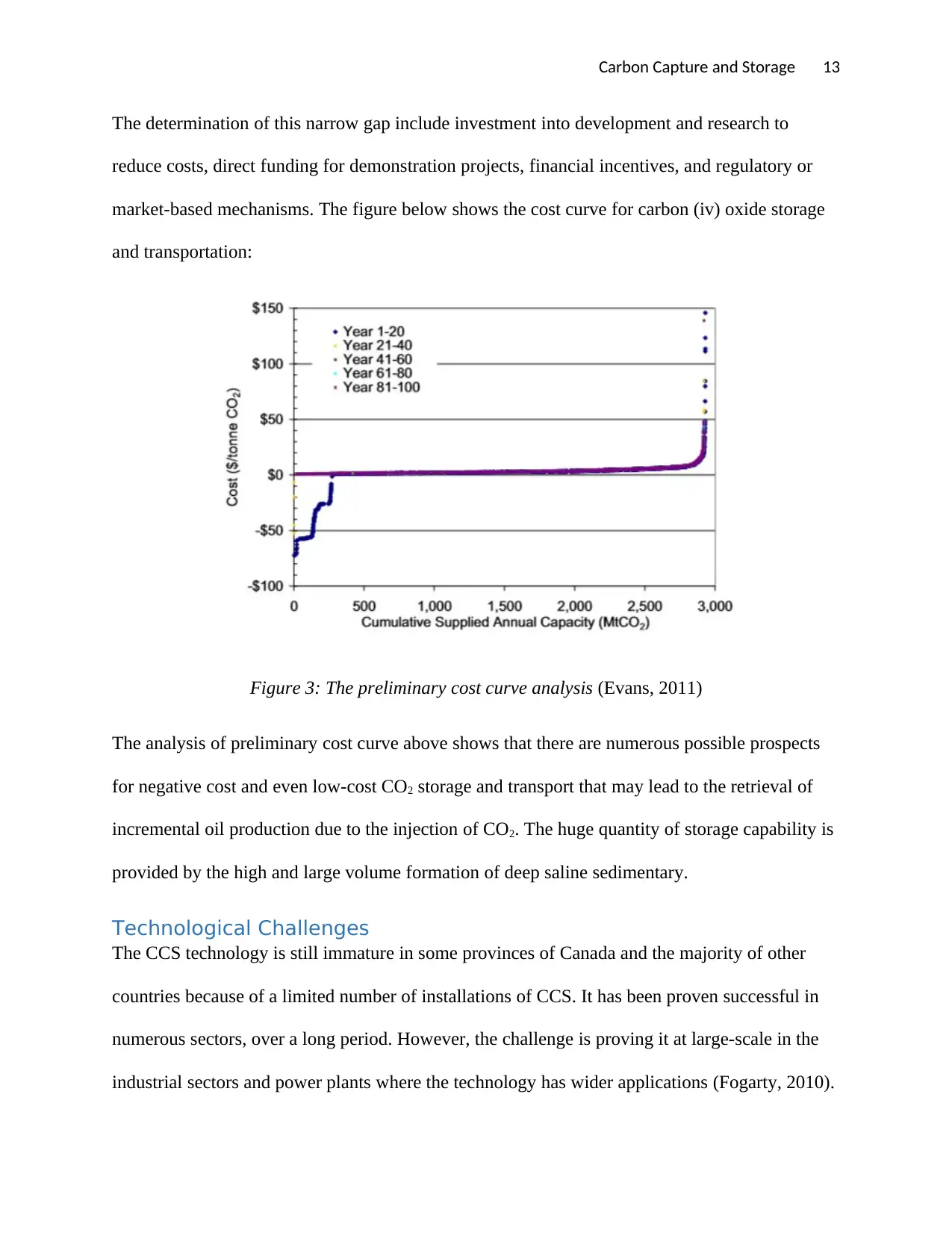
Carbon Capture and Storage 13
The determination of this narrow gap include investment into development and research to
reduce costs, direct funding for demonstration projects, financial incentives, and regulatory or
market-based mechanisms. The figure below shows the cost curve for carbon (iv) oxide storage
and transportation:
Figure 3: The preliminary cost curve analysis (Evans, 2011)
The analysis of preliminary cost curve above shows that there are numerous possible prospects
for negative cost and even low-cost CO2 storage and transport that may lead to the retrieval of
incremental oil production due to the injection of CO2. The huge quantity of storage capability is
provided by the high and large volume formation of deep saline sedimentary.
Technological Challenges
The CCS technology is still immature in some provinces of Canada and the majority of other
countries because of a limited number of installations of CCS. It has been proven successful in
numerous sectors, over a long period. However, the challenge is proving it at large-scale in the
industrial sectors and power plants where the technology has wider applications (Fogarty, 2010).
The determination of this narrow gap include investment into development and research to
reduce costs, direct funding for demonstration projects, financial incentives, and regulatory or
market-based mechanisms. The figure below shows the cost curve for carbon (iv) oxide storage
and transportation:
Figure 3: The preliminary cost curve analysis (Evans, 2011)
The analysis of preliminary cost curve above shows that there are numerous possible prospects
for negative cost and even low-cost CO2 storage and transport that may lead to the retrieval of
incremental oil production due to the injection of CO2. The huge quantity of storage capability is
provided by the high and large volume formation of deep saline sedimentary.
Technological Challenges
The CCS technology is still immature in some provinces of Canada and the majority of other
countries because of a limited number of installations of CCS. It has been proven successful in
numerous sectors, over a long period. However, the challenge is proving it at large-scale in the
industrial sectors and power plants where the technology has wider applications (Fogarty, 2010).
Paraphrase This Document
Need a fresh take? Get an instant paraphrase of this document with our AI Paraphraser
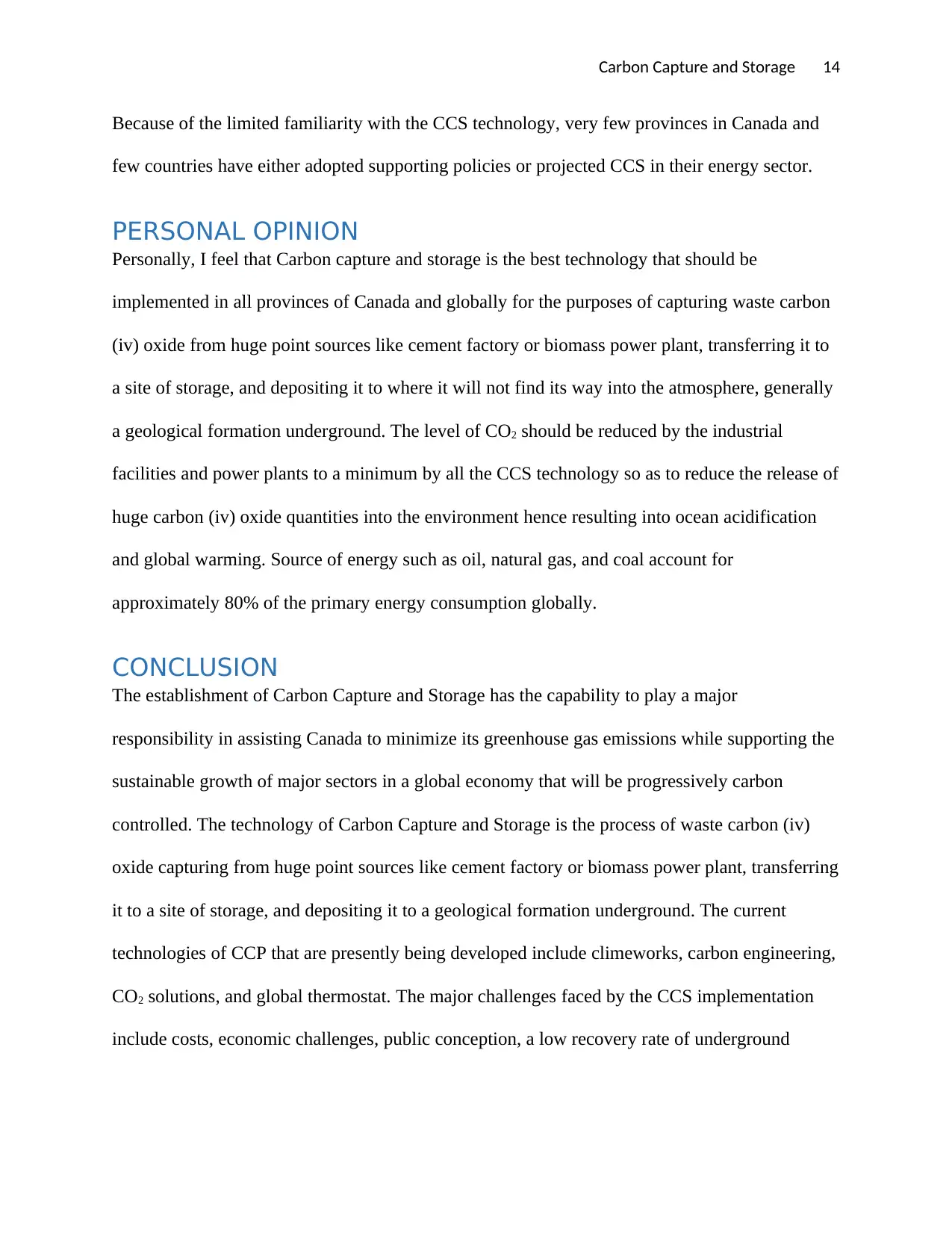
Carbon Capture and Storage 14
Because of the limited familiarity with the CCS technology, very few provinces in Canada and
few countries have either adopted supporting policies or projected CCS in their energy sector.
PERSONAL OPINION
Personally, I feel that Carbon capture and storage is the best technology that should be
implemented in all provinces of Canada and globally for the purposes of capturing waste carbon
(iv) oxide from huge point sources like cement factory or biomass power plant, transferring it to
a site of storage, and depositing it to where it will not find its way into the atmosphere, generally
a geological formation underground. The level of CO2 should be reduced by the industrial
facilities and power plants to a minimum by all the CCS technology so as to reduce the release of
huge carbon (iv) oxide quantities into the environment hence resulting into ocean acidification
and global warming. Source of energy such as oil, natural gas, and coal account for
approximately 80% of the primary energy consumption globally.
CONCLUSION
The establishment of Carbon Capture and Storage has the capability to play a major
responsibility in assisting Canada to minimize its greenhouse gas emissions while supporting the
sustainable growth of major sectors in a global economy that will be progressively carbon
controlled. The technology of Carbon Capture and Storage is the process of waste carbon (iv)
oxide capturing from huge point sources like cement factory or biomass power plant, transferring
it to a site of storage, and depositing it to a geological formation underground. The current
technologies of CCP that are presently being developed include climeworks, carbon engineering,
CO2 solutions, and global thermostat. The major challenges faced by the CCS implementation
include costs, economic challenges, public conception, a low recovery rate of underground
Because of the limited familiarity with the CCS technology, very few provinces in Canada and
few countries have either adopted supporting policies or projected CCS in their energy sector.
PERSONAL OPINION
Personally, I feel that Carbon capture and storage is the best technology that should be
implemented in all provinces of Canada and globally for the purposes of capturing waste carbon
(iv) oxide from huge point sources like cement factory or biomass power plant, transferring it to
a site of storage, and depositing it to where it will not find its way into the atmosphere, generally
a geological formation underground. The level of CO2 should be reduced by the industrial
facilities and power plants to a minimum by all the CCS technology so as to reduce the release of
huge carbon (iv) oxide quantities into the environment hence resulting into ocean acidification
and global warming. Source of energy such as oil, natural gas, and coal account for
approximately 80% of the primary energy consumption globally.
CONCLUSION
The establishment of Carbon Capture and Storage has the capability to play a major
responsibility in assisting Canada to minimize its greenhouse gas emissions while supporting the
sustainable growth of major sectors in a global economy that will be progressively carbon
controlled. The technology of Carbon Capture and Storage is the process of waste carbon (iv)
oxide capturing from huge point sources like cement factory or biomass power plant, transferring
it to a site of storage, and depositing it to a geological formation underground. The current
technologies of CCP that are presently being developed include climeworks, carbon engineering,
CO2 solutions, and global thermostat. The major challenges faced by the CCS implementation
include costs, economic challenges, public conception, a low recovery rate of underground

Carbon Capture and Storage 15
natural resources, regulatory and legislative framework, the long liability of CO2 stored, the
timing availability, the long-term safety of CO2 stored, and high-cost CO2 capture.
natural resources, regulatory and legislative framework, the long liability of CO2 stored, the
timing availability, the long-term safety of CO2 stored, and high-cost CO2 capture.
⊘ This is a preview!⊘
Do you want full access?
Subscribe today to unlock all pages.

Trusted by 1+ million students worldwide
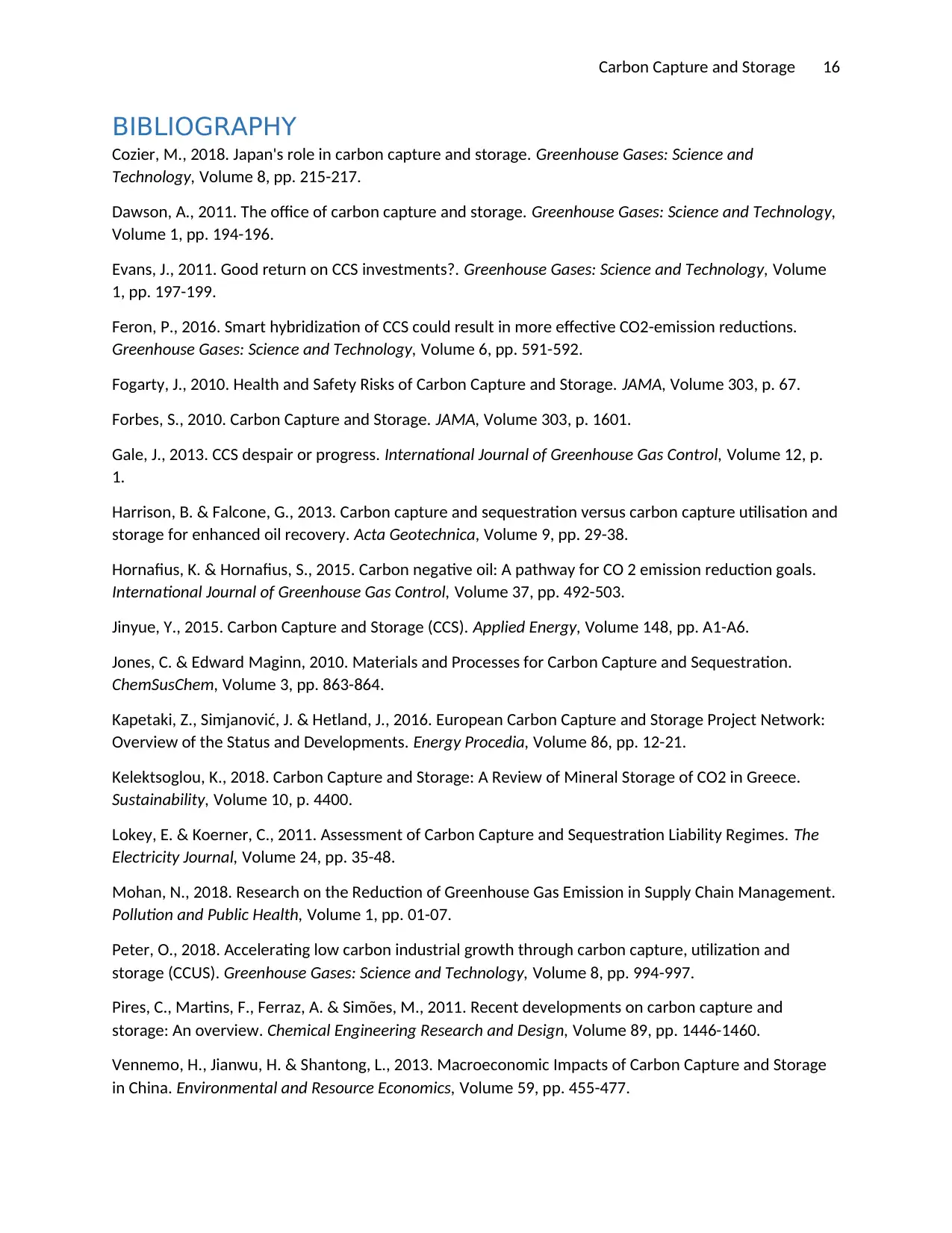
Carbon Capture and Storage 16
BIBLIOGRAPHY
Cozier, M., 2018. Japan's role in carbon capture and storage. Greenhouse Gases: Science and
Technology, Volume 8, pp. 215-217.
Dawson, A., 2011. The office of carbon capture and storage. Greenhouse Gases: Science and Technology,
Volume 1, pp. 194-196.
Evans, J., 2011. Good return on CCS investments?. Greenhouse Gases: Science and Technology, Volume
1, pp. 197-199.
Feron, P., 2016. Smart hybridization of CCS could result in more effective CO2-emission reductions.
Greenhouse Gases: Science and Technology, Volume 6, pp. 591-592.
Fogarty, J., 2010. Health and Safety Risks of Carbon Capture and Storage. JAMA, Volume 303, p. 67.
Forbes, S., 2010. Carbon Capture and Storage. JAMA, Volume 303, p. 1601.
Gale, J., 2013. CCS despair or progress. International Journal of Greenhouse Gas Control, Volume 12, p.
1.
Harrison, B. & Falcone, G., 2013. Carbon capture and sequestration versus carbon capture utilisation and
storage for enhanced oil recovery. Acta Geotechnica, Volume 9, pp. 29-38.
Hornafius, K. & Hornafius, S., 2015. Carbon negative oil: A pathway for CO 2 emission reduction goals.
International Journal of Greenhouse Gas Control, Volume 37, pp. 492-503.
Jinyue, Y., 2015. Carbon Capture and Storage (CCS). Applied Energy, Volume 148, pp. A1-A6.
Jones, C. & Edward Maginn, 2010. Materials and Processes for Carbon Capture and Sequestration.
ChemSusChem, Volume 3, pp. 863-864.
Kapetaki, Z., Simjanović, J. & Hetland, J., 2016. European Carbon Capture and Storage Project Network:
Overview of the Status and Developments. Energy Procedia, Volume 86, pp. 12-21.
Kelektsoglou, K., 2018. Carbon Capture and Storage: A Review of Mineral Storage of CO2 in Greece.
Sustainability, Volume 10, p. 4400.
Lokey, E. & Koerner, C., 2011. Assessment of Carbon Capture and Sequestration Liability Regimes. The
Electricity Journal, Volume 24, pp. 35-48.
Mohan, N., 2018. Research on the Reduction of Greenhouse Gas Emission in Supply Chain Management.
Pollution and Public Health, Volume 1, pp. 01-07.
Peter, O., 2018. Accelerating low carbon industrial growth through carbon capture, utilization and
storage (CCUS). Greenhouse Gases: Science and Technology, Volume 8, pp. 994-997.
Pires, C., Martins, F., Ferraz, A. & Simões, M., 2011. Recent developments on carbon capture and
storage: An overview. Chemical Engineering Research and Design, Volume 89, pp. 1446-1460.
Vennemo, H., Jianwu, H. & Shantong, L., 2013. Macroeconomic Impacts of Carbon Capture and Storage
in China. Environmental and Resource Economics, Volume 59, pp. 455-477.
BIBLIOGRAPHY
Cozier, M., 2018. Japan's role in carbon capture and storage. Greenhouse Gases: Science and
Technology, Volume 8, pp. 215-217.
Dawson, A., 2011. The office of carbon capture and storage. Greenhouse Gases: Science and Technology,
Volume 1, pp. 194-196.
Evans, J., 2011. Good return on CCS investments?. Greenhouse Gases: Science and Technology, Volume
1, pp. 197-199.
Feron, P., 2016. Smart hybridization of CCS could result in more effective CO2-emission reductions.
Greenhouse Gases: Science and Technology, Volume 6, pp. 591-592.
Fogarty, J., 2010. Health and Safety Risks of Carbon Capture and Storage. JAMA, Volume 303, p. 67.
Forbes, S., 2010. Carbon Capture and Storage. JAMA, Volume 303, p. 1601.
Gale, J., 2013. CCS despair or progress. International Journal of Greenhouse Gas Control, Volume 12, p.
1.
Harrison, B. & Falcone, G., 2013. Carbon capture and sequestration versus carbon capture utilisation and
storage for enhanced oil recovery. Acta Geotechnica, Volume 9, pp. 29-38.
Hornafius, K. & Hornafius, S., 2015. Carbon negative oil: A pathway for CO 2 emission reduction goals.
International Journal of Greenhouse Gas Control, Volume 37, pp. 492-503.
Jinyue, Y., 2015. Carbon Capture and Storage (CCS). Applied Energy, Volume 148, pp. A1-A6.
Jones, C. & Edward Maginn, 2010. Materials and Processes for Carbon Capture and Sequestration.
ChemSusChem, Volume 3, pp. 863-864.
Kapetaki, Z., Simjanović, J. & Hetland, J., 2016. European Carbon Capture and Storage Project Network:
Overview of the Status and Developments. Energy Procedia, Volume 86, pp. 12-21.
Kelektsoglou, K., 2018. Carbon Capture and Storage: A Review of Mineral Storage of CO2 in Greece.
Sustainability, Volume 10, p. 4400.
Lokey, E. & Koerner, C., 2011. Assessment of Carbon Capture and Sequestration Liability Regimes. The
Electricity Journal, Volume 24, pp. 35-48.
Mohan, N., 2018. Research on the Reduction of Greenhouse Gas Emission in Supply Chain Management.
Pollution and Public Health, Volume 1, pp. 01-07.
Peter, O., 2018. Accelerating low carbon industrial growth through carbon capture, utilization and
storage (CCUS). Greenhouse Gases: Science and Technology, Volume 8, pp. 994-997.
Pires, C., Martins, F., Ferraz, A. & Simões, M., 2011. Recent developments on carbon capture and
storage: An overview. Chemical Engineering Research and Design, Volume 89, pp. 1446-1460.
Vennemo, H., Jianwu, H. & Shantong, L., 2013. Macroeconomic Impacts of Carbon Capture and Storage
in China. Environmental and Resource Economics, Volume 59, pp. 455-477.
Paraphrase This Document
Need a fresh take? Get an instant paraphrase of this document with our AI Paraphraser

Carbon Capture and Storage 17
Watt, J., 2012. Introduction to carbon capture and storage. Engineering & Technology Reference,
Volume 1.
Xie, L., 2014. Application of Carbon Capture and Sequestration in Clean Energy Cycle Technology.
Applied Mechanics and Materials, Volume 608, pp. 1041-1045.
Watt, J., 2012. Introduction to carbon capture and storage. Engineering & Technology Reference,
Volume 1.
Xie, L., 2014. Application of Carbon Capture and Sequestration in Clean Energy Cycle Technology.
Applied Mechanics and Materials, Volume 608, pp. 1041-1045.
1 out of 17
Related Documents
Your All-in-One AI-Powered Toolkit for Academic Success.
+13062052269
info@desklib.com
Available 24*7 on WhatsApp / Email
![[object Object]](/_next/static/media/star-bottom.7253800d.svg)
Unlock your academic potential
© 2024 | Zucol Services PVT LTD | All rights reserved.





